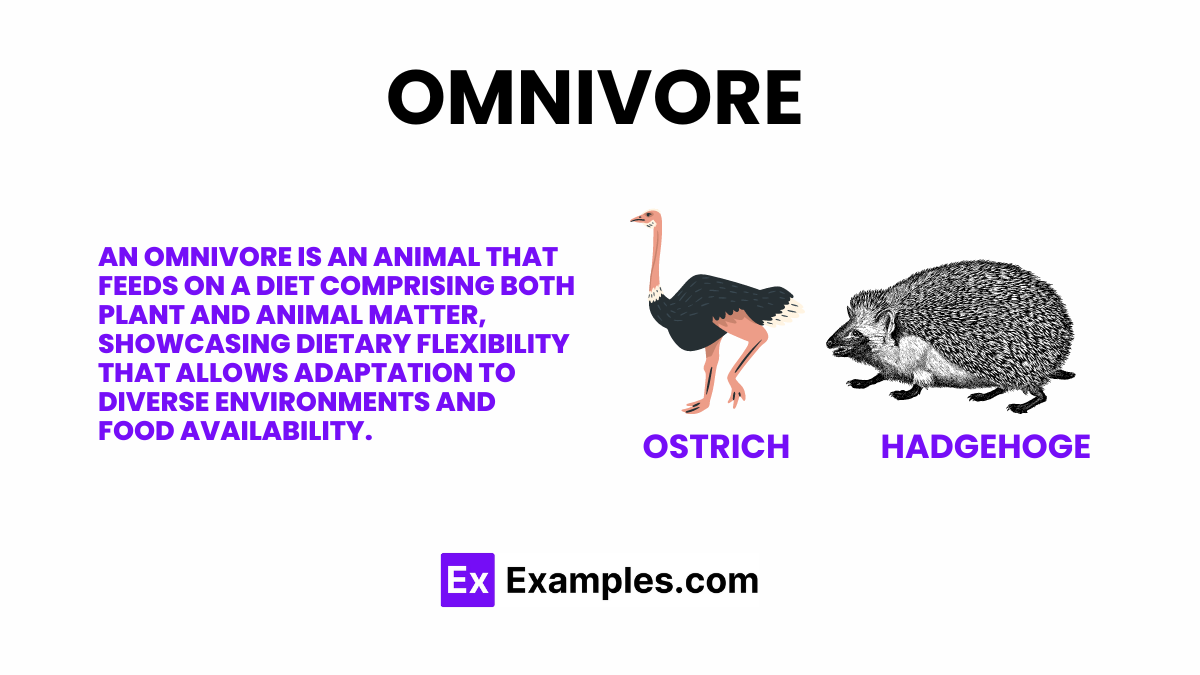Which of the following animals is an omnivore?
Lion
Cow
Bear
Eagle


The intriguing world of omnivores with our comprehensive guide, where versatility meets survival. Omnivores, creatures that consume both plant and animal matter, play a crucial role in maintaining ecological balance. From the cunning foxes to the adaptable bears, and even humans, this guide explores the diverse diet, unique adaptations, and ecological impact of omnivores. Packed with fascinating examples and insights, it’s your gateway to understanding nature’s most versatile eaters.
An omnivore is an animal that eats both plants and animals as part of its regular diet. This means they can enjoy a wide variety of foods, from fruits and vegetables to meat and fish, giving them the flexibility to adapt to different environments and food availability. Omnivores play an important role in the ecosystem by helping to control populations of both plants and other animals
The best example of an omnivore is the bear, specifically the brown bear (Ursus arctos). Brown bears have a diet that includes both plants and animals, ranging from fruits, nuts, and leaves to fish, small mammals, and carrion. This adaptability in diet allows them to thrive in diverse environments, showcasing the true nature of omnivorous animals.
Omnivores are animals that have a diet consisting of both plant and animal matter, which results in a range of distinctive characteristics that help them thrive in diverse environments:
Omnivores are fascinating creatures due to their dietary flexibility. Here are some interesting facts about them:
| Feature | Omnivore | Carnivore | Herbivore |
|---|---|---|---|
| Diet | Eats both plants and animals. | Eats primarily meat from other animals. | Eats exclusively plant materials. |
| Teeth Structure | Mixed teeth: sharp for meat, flat for plants. | Sharp, pointed teeth for tearing flesh. | Flat, broad teeth for grinding plant material. |
| Digestive System | Relatively simple, can process varied diet. | Simple and short, specialized for meat. | Complex, specialized for fermenting plant matter. |
| Jaw Movement | Both vertical and horizontal for varied diet. | Vertical movement for biting and tearing. | Horizontal movement for grinding. |
| Examples | Humans, bears, pigs. | Lions, tigers, wolves. | Cows, deer, elephants. |
| Role in Ecosystem | Versatile, can be both predator and prey. | Predators, control prey populations. | Control plant populations, aid in seed dispersal. |
| Adaptations | Versatile diet allows adaptation to many environments. | Adaptations for hunting and meat digestion. | Adaptations for digesting cellulose, large stomachs for fermentation. |
| Energy Source | Both plant carbs/fats and animal proteins/fats. | Animal proteins and fats. | Plant carbs, proteins, and some fats. |
| Common Name | Scientific Name |
| Human | Homo sapiens |
| Brown Bear | Ursus arctos |
| Raccoon | Procyon lotor |
| Pig | Sus scrofa |
| American Black Bear | Ursus americanus |
| Chimpanzee | Pan troglodytes |
| Common Crow | Corvus brachyrhynchos |
| Red Fox | Vulpes vulpes |
| Domestic Dog | Canis lupus familiaris |
| Coati | Nasua nasua |
| Virginia Opossum | Didelphis virginiana |
| Grizzly Bear | Ursus arctos horribilis |
| Badger | Meles meles |
| Hedgehog | Erinaceus europaeus |
| Skunk | Mephitis mephitis |
| Raccoon Dog | Nyctereutes procyonoides |
| Common Raccoon | Procyon lotor |
| Bonobo | Pan paniscus |
| White-Faced Capuchin | Cebus capucinus |
| North American Porcupine | Erethizon dorsatum |
While omnivores can survive on both meat and plants, their healthiest diet includes a balance of both to meet nutritional needs and ensure optimal health.
Omnivores have a digestive system that efficiently processes both plant and animal matter, thanks to enzymes and gut structures adapted for a varied diet.
Yes, humans are classified as omnivores, capable of consuming and digesting a wide range of plant and animal foods, reflecting diverse dietary habits globally.
Omnivores play a crucial role in ecosystems by controlling populations of both prey and plants, helping to maintain balance and biodiversity in their habitats.
Omnivores can be identified by their diverse diet, mixed teeth structure for grinding plants and tearing meat, and their adaptation to varied environments.
Omnivores, with their adaptable diets consuming both plant and animal matter, play a pivotal role in ecosystems by maintaining balance and promoting biodiversity. Their unique dietary flexibility allows them to thrive in various habitats, highlighting the complexity and interconnectedness of nature. Understanding omnivores enriches our appreciation of the diverse strategies animals use to survive and flourish on our planet.
Text prompt
Add Tone
What is an Omnivore?
Characteristics of Omnivores
Which of the following animals is an omnivore?
Lion
Cow
Bear
Eagle
Omnivores have a diet consisting of:
Only plants
Only animals
Both plants and animals
Neither plants nor animals
Which of the following is NOT an example of an omnivore?
Human
Pig
Raccoon
Rabbit
Which bird is considered an omnivore?
Crow
Eagle
Sparrow
Penguin
Why are humans classified as omnivores?
They can digest cellulose.
They have a diet that includes both plant and animal products.
They only eat meat.
They only eat plants.
Which of the following statements is true about omnivores?
They only eat meat during winter.
They only eat plants during summer.
They can adapt to various food sources available in their environment.
They only eat processed food.
An example of an omnivorous diet for humans includes:
Steak and salad
Bread and butter
Pasta and cheese
Rice and beans
Which omnivorous animal is known for scavenging?
Deer
Shark
Hyena
Tiger
Omnivores play an important role in ecosystems by:
Being primary producers
Maintaining a balance between plant and animal populations
Only eating decomposed material
Not affecting the ecosystem
Which primate is known to be omnivorous?
Gorilla
Chimpanzee
Lemur
Orangutan
Before you leave, take our quick quiz to enhance your learning!

